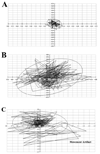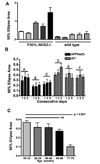Quantitative measurement of postural sway in mouse models of human neurodegenerative disease
- PMID: 17764851
- PMCID: PMC2175386
- DOI: 10.1016/j.neuroscience.2007.07.025
Quantitative measurement of postural sway in mouse models of human neurodegenerative disease
Abstract
Detection of motor dysfunction in genetic mouse models of neurodegenerative disease requires reproducible, standardized and sensitive behavioral assays. We have utilized a center of pressure (CoP) assay in mice to quantify postural sway produced by genetic mutations that affect motor control centers of the brain. As a positive control for postural instability, wild type mice were injected with harmaline, a tremorigenic agent, and the average areas of the 95% confidence ellipse, which measures 95% of the CoP trajectory values recorded in a single trial, were measured. Ellipse area significantly increased in mice treated with increasing doses of harmaline and returned to control values after recovery. We also examined postural sway in mice expressing mutations that mimic frontotemporal dementia with Parkinsonism linked to chromosome 17 (FTDP-17) (T-279, P301L or P301L-nitric oxide synthase 2 (NOS2)(-/-) mice) and that demonstrate motor symptoms. These mice were then compared with a mouse model of Alzheimer's disease (APPSwDI mice) that demonstrates cognitive, but not motor deficits. T-279 and P301L-NOS2(-/-) mice demonstrated a significant increase in CoP ellipse area compared with appropriate wild type control mice or to mice expressing the P301L mutation alone. In contrast, postural instability was significantly reduced in APPSwDI mice that have cognitive deficits but do not have associated motor deficits. The CoP assay provides a simple, sensitive and quantitative tool to detect motor deficits resulting from postural abnormalities in mice and may be useful in understanding the underlying mechanisms of disease.
Figures






Similar articles
-
Static and dynamic postural control deficits in aging fragile X mental retardation 1 (FMR1) gene premutation carriers.J Neurodev Disord. 2019 Jan 21;11(1):2. doi: 10.1186/s11689-018-9261-x. J Neurodev Disord. 2019. PMID: 30665341 Free PMC article.
-
mNos2 deletion and human NOS2 replacement in Alzheimer disease models.J Neuropathol Exp Neurol. 2014 Aug;73(8):752-69. doi: 10.1097/NEN.0000000000000094. J Neuropathol Exp Neurol. 2014. PMID: 25003233 Free PMC article.
-
Sway regularity and sway activity in older adults' upright stance are differentially affected by dual task.Neurosci Lett. 2018 Feb 14;666:153-157. doi: 10.1016/j.neulet.2017.12.054. Epub 2017 Dec 26. Neurosci Lett. 2018. PMID: 29288047
-
Assessment of postural control in patients with Parkinson's disease: sway ratio analysis.Hum Mov Sci. 2011 Apr;30(2):396-404. doi: 10.1016/j.humov.2010.07.017. Epub 2010 Aug 30. Hum Mov Sci. 2011. PMID: 20800915
-
Development of a more robust tool for postural stability analysis of laparoscopic surgeons.Surg Endosc. 2008 Apr;22(4):1087-92. doi: 10.1007/s00464-007-9664-3. Epub 2007 Nov 20. Surg Endosc. 2008. PMID: 18030522
Cited by
-
Identification of New Biomarkers of Posturo-Locomotor Instability in a Rodent Model of Vestibular Pathology.Front Neurol. 2020 May 29;11:470. doi: 10.3389/fneur.2020.00470. eCollection 2020. Front Neurol. 2020. PMID: 32547480 Free PMC article.
-
Loss of calcitonin gene-related peptide (αCGRP) and use of a vestibular challenge highlight balance deficiencies in aging mice.PLoS One. 2024 Jun 12;19(6):e0303801. doi: 10.1371/journal.pone.0303801. eCollection 2024. PLoS One. 2024. PMID: 38865379 Free PMC article.
-
Robust alternative to the righting reflex to assess arousal in rodents.Sci Rep. 2020 Nov 20;10(1):20280. doi: 10.1038/s41598-020-77162-3. Sci Rep. 2020. PMID: 33219247 Free PMC article.
-
Imaging brain glucose metabolism in vivo reveals propionate as a major anaplerotic substrate in pyruvate dehydrogenase deficiency.Cell Metab. 2024 Jun 4;36(6):1394-1410.e12. doi: 10.1016/j.cmet.2024.05.002. Cell Metab. 2024. PMID: 38838644 Free PMC article.
-
Postural control during quiet bipedal standing in rats.PLoS One. 2017 Dec 15;12(12):e0189248. doi: 10.1371/journal.pone.0189248. eCollection 2017. PLoS One. 2017. PMID: 29244818 Free PMC article.
References
-
- Arendash G, Lewis J, Leighty R, McGowan E, Cracchiolo J, Hutton M, Garcia M. Multi-metric behavioral comparison of APPsw and P301L models for Alzheimer's disease: linkage of poorer cognitive performance to tau pathology in forebrain. Brain Res. 2004;1012:29–41. - PubMed
-
- Bove M, Marinelli L, Avanzino L, Marchese R, Abbruzzese G. Posturigraphic analysis of balance control in patients with essential tremor. Movement Disord. 2006;21:192–198. - PubMed
-
- Braak H, Ghebremedhim E, Rub U, Bratzke H, Del Tredici K. Stages in the development of Parkinson's disease related pathology. Cell Tissue Res. 2004;318:121–134. - PubMed
-
- Cenci MA, Whishaw IQ, Schallert T. Animal models of neurological deficits: how relevant is the rat? Nat Rev. 2002;3:574–579. - PubMed
MeSH terms
Substances
Grants and funding
LinkOut - more resources
Full Text Sources
Medical
Molecular Biology Databases
Research Materials

